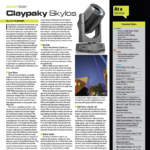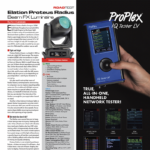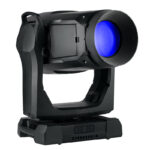Avolites has been in the console game for a long time, but their popularity in the States was never as strong as in Europe. The choice of a console is a very personal matter for any LD, and — full disclosure — for many years, I chose to use consoles other than Avolites because I had a perception that they were difficult to use. The Titan operating system, introduced almost concurrently with an updated line of Avo consoles, however, sought to change all that, and today we’re going to look at their latest offering — the Avolites Arena.
Layout
Physically, the console is 42 by 16 inches (WxD). Across the front panel are 40 playback faders along with 20 executor buttons, all of which are fully programmable. The console’s three main features start with the large (almost 16-inch) main touch screen. There’s a secondary touch screen off to the right for additional control, and there are three large encoders. The console also offers four additional programmable rotary knobs to the right of the secondary screen. Each group of faders has an individual LCD above it for labeling and button function information, except for the 10 main playbacks, which use the main screen.
On the rear panel are eight physical 5-pin DMX outputs (which are fully assignable), and the console can also control up to 16 universes of DMX via Art-Net or sACN before additional TitanNet processors are recommended. The entire system is expandable up to 64 universes. There are inputs for SMPTE and MIDI timecode, audio triggering, and external peripherals like a mouse or keyboard, along with opticalCON and Ethernet ports and a built-in managed switch. The really interesting stuff, however, lies under the hood, with the software.
The Titan System
The heart of the system is the Titan operating system. Patching is quite simple, with quick search functions to find your lights, and a full and frequently updated library maintained by Avolites. There is a fixture builder wizard for getting yourself out of dire situations. One interesting and especially useful feature here is the Find Fixture function, which allows the user to send a locate value (explained below) to a fixture that is not yet patched — useful in situations where the patch isn’t known, or might be incorrect.
Once patched, fixtures automatically appear in the fixture pool, and the console will make basic groups such as All, Odd or Even, if desired. Making your own is easy, however — simply drag your finger across the fixtures you want (like selecting files on a computer) and double-tap an empty group. In keeping with the visual nature of Titan, names (“Legends”) can be set on most elements with text labels or, alternately, a library of built-in icons, pictures or sketches that you can draw yourself. You can draw, for example, a set of arrows showing which way the lights are going, or use a swath of color, or perhaps a visual representation of a gobo.

Different Philosophies
Titan has a number of underlying philosophies that must be understood if one is to make full use of its capabilities, chief among these being a dedication to programming being a visual experience with a minimum of keystrokes, not numbers. The user is encouraged in a myriad of ways to think in terms of what the lights are literally doing, not in terms of values. For instance, to make a palette, simply enter information into your lights, and double tap an empty preset in the pool (or tap an existing one, if you wish to update that preset). The process of “batch editing” in a cue’s spreadsheet view is another example of visual control. Simply touch an attribute and then touch a value, and it updates automatically.
The second major philosophy difference regards how Avolites regards the behavior of Latest Takes Precedence (LTP). On most consoles, lights have a default position defined by their fixture profile, which the user changes via the programmer, and once the values are stored, releases (or “clears”) back to the default position. On Avolites consoles, the lights do not return to their home position once the programmer is cleared; they stay at whatever value they were last in until moved again. (By default, this can be changed in the console options.) To reset a group of lights for programming, one sends a Locate command to them, which generally moves them to 50 / 50 pan / tilt and / or open white, and from there the operator can input whatever data they wish. This took me some time to wrap my head around — the only time the lights are at their “home” position is when the console first starts up. From there, they retain whatever state they’re in until told otherwise: the “Clear” button clears the programmer, not the values the lights currently have. The Locate function is separate from the Highlight feature and from the programmer; it assigns values to the lights without altering the information in the programmer.
Once you understand these concepts, you can start to see the full potential of the Titan software. Of course, the expected functions like cuelists, chases and macros are here, but so, too, are powerful busking options, such as syntax to move a group of lights to a preset over a specified amount of time. If you decide that you want to make some arbitrary group of playback handles into a cuelist, you can do a “Quick Build” — select the playbacks in their playback order, and the console builds a quick cuelist for you from the information in those playbacks.
Titan’s new effect generator is called the “Keyframe Shape Generator,” and it allows the user to input an unlimited number of “keyframes,” which are somewhat analogous to cues, and loop them while having complete control over the timing, phase, and direction attributes. To build keyframe shapes, you select your fixtures, enter some information via the programmer or via palettes, and go to the next keyframe. When you’re done entering keyframes, the console shows you a visual representation of the timing and changes, which you are free to move any way you like, change the phase on, or anything else you like. It’s a little complicated to describe, but I found it an interesting way to make effects quickly.
There are also built-in spatial direction tools which can automatically start the effect from the inside out in a group of fixtures, from the outside in, or any direction you’d like — and it works on two-dimensional matrices of lights too, not just lines of fixtures. To add to the power of this system, you can have up to four layers per effect running at once, and tools to synchronize layers in time are included. The legacy Avolites Shape Generator is also available for those effects you can’t make with the keyframe generator. There’s also an advanced pixel-mapping engine here, which allows for the importing of external bitmaps but also comes with several tools for building shapes on the fly, such as basic shapes, text, and Quick Sketch functionality for drawing your own basic pictures in the console. There are several animation settings and presets for adding movement along with support for multiple simultaneous layers.
Titan supports a variety of networking operation modes, including multiuser and full tracking backup. Multiple programmers can work on the show at the same time, working either in collaboration or separately on the same show, and users can have their own settings, handle layouts, and make changes to any part of the show.
Console and size selection is a personal choice, but the Arena with the Titan software certainly demonstrates that Avolites has the technological acumen to play at the highest levels of the industry, and includes some truly innovative features to make programming fast and enjoyable.
At a Glance
Leveraging Titan’s Focus on Visual Control
Avolite’s Arena console makes use of the company’s Titan operating system, which incorporates two key differences in lighting control philosophy. The first is a commitment to make programming a visual experience — selecting a gobo, for example, by tapping on something that looks like the gobo you want. The second big difference is LTP — “Latest Takes Preference.” In this environment, lights do not return to their home position once the programmer is cleared; they stay at whatever value they were last at until they get moved again.
Avolites Arena Console
PROS: Solid, feature-rich software suite
CONS: None
Features:
- 40 Playback Faders
- 20 Executor Buttons
- 15.6″ Touch Screen
- 7” Secondary Screen
- UPS Battery Backup
- Up to 64 Universes of Output with Titan Net
- Compatible with Titan Remote mobile app
SPECS:
- Size: 42” x 17” x 6”
- Weight: 97 lbs. in flight case
- MSRP: $21,995 includes cover, lamps, spares kit and flight case
- Manufacturer: Avolites
- More Info: www.avolites.com



